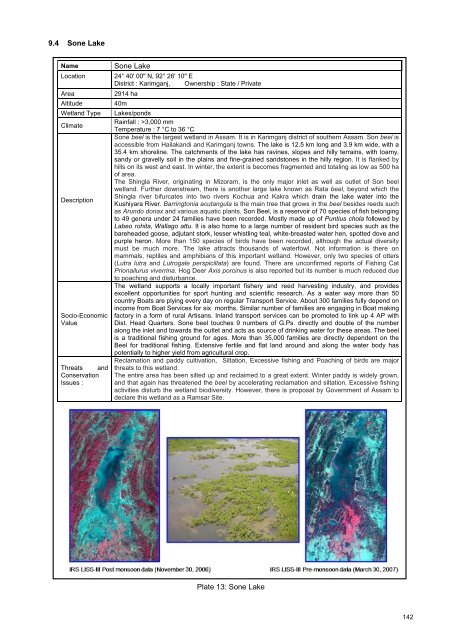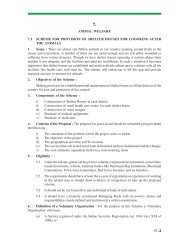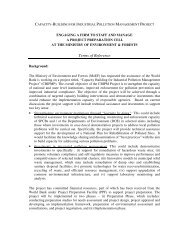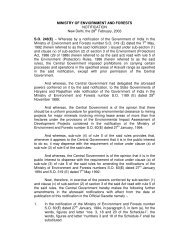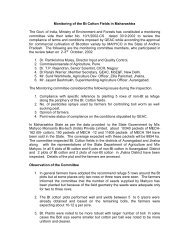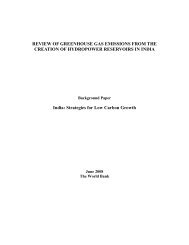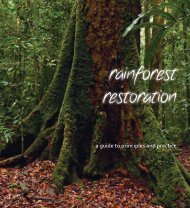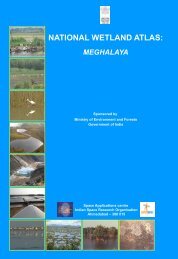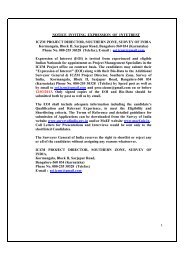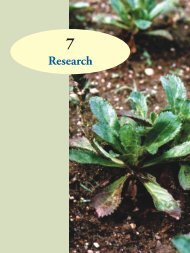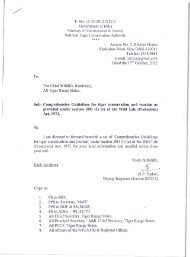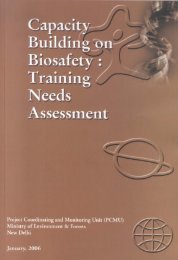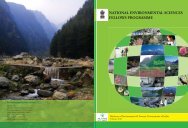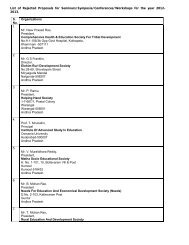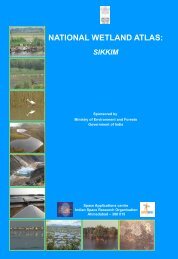Assam - Ministry of Environment and Forests
Assam - Ministry of Environment and Forests
Assam - Ministry of Environment and Forests
You also want an ePaper? Increase the reach of your titles
YUMPU automatically turns print PDFs into web optimized ePapers that Google loves.
9.4 Sone Lake<br />
Name<br />
Location<br />
Area<br />
Altitude<br />
Wetl<strong>and</strong> Type<br />
Climate<br />
Description<br />
Socio-Economic<br />
Value<br />
Threats <strong>and</strong><br />
Conservation<br />
Issues :<br />
Sone Lake<br />
24° 40' 00" N, 92° 26' 10" E<br />
District : Karimganj, Ownership : State / Private<br />
2914 ha<br />
40m<br />
Lakes/ponds<br />
Rainfall : >3,000 mm<br />
Temperature : 7 °C to 36 °C<br />
Sone beel is the largest wetl<strong>and</strong> in <strong>Assam</strong>. It is in Karimganj district <strong>of</strong> southern <strong>Assam</strong>. Son beel is<br />
accessible from Hailak<strong>and</strong>i <strong>and</strong> Karimganj towns. The lake is 12.5 km long <strong>and</strong> 3.9 km wide, with a<br />
35.4 km shoreline. The catchments <strong>of</strong> the lake has ravines, slopes <strong>and</strong> hilly terrains, with loamy,<br />
s<strong>and</strong>y or gravelly soil in the plains <strong>and</strong> fine-grained s<strong>and</strong>stones in the hilly region. It is flanked by<br />
hills on its west <strong>and</strong> east. In winter, the extent is becomes fragmented <strong>and</strong> totaling as low as 500 ha<br />
<strong>of</strong> area.<br />
The Shingla River, originating in Mizoram, is the only major inlet as well as outlet <strong>of</strong> Son beel<br />
wetl<strong>and</strong>. Further downstream, there is another large lake known as Rata beel, beyond which the<br />
Shingla river bifurcates into two rivers Kochua <strong>and</strong> Kakra which drain the lake water into the<br />
Kushiyara River. Barringtonia acutangula is the main tree that grows in the beel besides reeds such<br />
as Arundo donax <strong>and</strong> various aquatic plants. Son Beel, is a reservoir <strong>of</strong> 70 species <strong>of</strong> fish belonging<br />
to 49 genera under 24 families have been recorded. Mostly made up <strong>of</strong> Puntius chola followed by<br />
Labeo rohita, Wallago attu. It is also home to a large number <strong>of</strong> resident bird species such as the<br />
bareheaded goose, adjutant stork, lesser whistling teal, white-breasted water hen, spotted dove <strong>and</strong><br />
purple heron. More than 150 species <strong>of</strong> birds have been recorded, although the actual diversity<br />
must be much more. The lake attracts thous<strong>and</strong>s <strong>of</strong> waterfowl. Not information is there on<br />
mammals, reptiles <strong>and</strong> amphibians <strong>of</strong> this important wetl<strong>and</strong>. However, only two species <strong>of</strong> otters<br />
(Lutra lutra <strong>and</strong> Lutrogale perspicillata) are found. There are unconfirmed reports <strong>of</strong> Fishing Cat<br />
Prionailurus viverrina. Hog Deer Axis porcinus is also reported but its number is much reduced due<br />
to poaching <strong>and</strong> disturbance.<br />
The wetl<strong>and</strong> supports a locally important fishery <strong>and</strong> reed harvesting industry, <strong>and</strong> provides<br />
excellent opportunities for sport hunting <strong>and</strong> scientific research. As a water way more than 50<br />
country Boats are plying every day on regular Transport Service. About 300 families fully depend on<br />
income from Boat Services for six months. Similar number <strong>of</strong> families are engaging in Boat making<br />
factory in a form <strong>of</strong> rural Artisans. Inl<strong>and</strong> transport services can be promoted to link up 4 AP with<br />
Dist. Head Quarters. Sone beel touches 9 numbers <strong>of</strong> G.Ps. directly <strong>and</strong> double <strong>of</strong> the number<br />
along the inlet <strong>and</strong> towards the outlet <strong>and</strong> acts as source <strong>of</strong> drinking water for these areas. The beel<br />
is a traditional fishing ground for ages. More than 35,000 families are directly dependent on the<br />
Beel for traditional fishing. Extensive fertile <strong>and</strong> flat l<strong>and</strong> around <strong>and</strong> along the water body has<br />
potentially to higher yield from agricultural crop.<br />
Reclamation <strong>and</strong> paddy cultivation, Siltation, Excessive fishing <strong>and</strong> Poaching <strong>of</strong> birds are major<br />
threats to this wetl<strong>and</strong>.<br />
The entire area has been silted up <strong>and</strong> reclaimed to a great extent. Winter paddy is widely grown,<br />
<strong>and</strong> that again has threatened the beel by accelerating reclamation <strong>and</strong> siltation. Excessive fishing<br />
activities disturb the wetl<strong>and</strong> biodiversity. However, there is proposal by Government <strong>of</strong> <strong>Assam</strong> to<br />
declare this wetl<strong>and</strong> as a Ramsar Site.<br />
Plate 13: Sone Lake<br />
142


